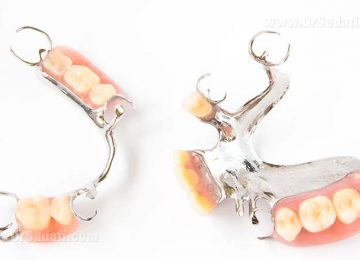
Dental Implants
Any external object that is surgically positioned into body tissues is called implant. Dental implants are titanium posts which are like tooth roots in a shape of a screw. Dental implants are constant, efficacious alternatives of dental roots and they have high compatibility with body cells. They are surgically positioned into jawbone beneath your gum and about 3 or 4 months is required to graft to your jawbone (now it’s ready for prosthodontics).
All implants consists of two main components:
- Fixture: the screw-like roots which is surgically positioned to the jawbone beneath your gum.
- Abutment: the prosthesis-like component which is mount onto fixture (3-4 months after merging fixture with the jawbone) to protect the prosthodontics. Whether a fixed prosthodontics as a dental crown, or a movable one like a denture (also called over denture.)

The advantages of dental implants
- Being an appropriate alternative for your tooth is the most and the best privilege of a dental implant. If patients are not able to have dental implants due to various reasons, there won’t be other definite therapy. (if there will, it doesn’t have a desirable quality.) One of these treatments is usual removable prosthesis which has many defects such as: insensibility of the real tooth, loosening the new tooth.
- We have 2 kinds of implants: constant or inconstant.
- Constant implants: the advantages of this type of implants are that patients feel it as their natural tooth and they are released of issues like being toothless or having denture. If we couldn’t mount many implants due to different reasons such as: inadequate bones, unhealthy gums, physical or economic conditions, the other treatment is to use less implants. (About four for the upper jaw and two for the lower jaw.)
- Inconstant implants: such as denture (complete prosthesis) which will be mount on the implant like a lock and key. These kinds of prosthodontics are much better than the normal dentures which are without implants due to the variety of reasons like having less looseness and chewing more easily than the normal dentures.
- Having an implant can prevent your jawbone to be atrophy because the fixture which exists in the implant would conserve your bone and your face won’t get fatigue or old by time duration.


Consultation and the treatment plan
After the first clinical examinations and consultations, prosthodontist or the doctor of prosthodontics plans the treatments based on the patient’s needs. He determines the locations and numbers of implants by his plan. Then an implant radiography (CBCT) would be prescribed in order to assess the quality and quantity of the bone. (If patients need to have bone grafting or sinus lifting or even moving nerves…) After all assessments, the dental implant therapy would be began which consists of surgically mounting the fixture. The time of handing the prosthodontics over to the patients depends on the type of the surgery and bone graft and the quality or the quantity of the jawbone. It can be one week after the surgery or it may requires 2-5 months for the recovery of the bone surrounding the implant. The whole period of a dental implant therapy depends on the patient’s situation and it would be variable from one week to six months.
Different types of dental implants

In recent years, considering the high popularity of implants as an alternative for lost teeth, there is a great variety of implants (about 500 types) in the global markets. Implants have got different prices and it depends on different factors such as: the type of implant, the physician (prosthodontist or general practitioner) who does the therapy, or if it will be supported by any reputable company in the domestic market!
The methods of dental implant therapy
- Immediate implantation: if your jawbone or mouth has appropriate conditions, the implants can be mount as soon as your teeth would be pulled and the prosthesis can be given to you a few days after the surgery.
- Tardily implantation: often due to the reasons as gum and tooth infections and inadequate bones, patients must wait 2 months after pulling their tooth (Your bone requires this timeframe to be recovered also will be added to the treatment duration.) and after these months their prosthodontics will be given to them although they can have some temporary prosthesis to avoid being toothless during these 2 months.

Some hints about dental implants
Dental Implants typically categorized based on the type of procedure used to place them :
- Single-stage implants: we just have one surgery which is mounting the fixture (which is apparent inside the gum) and immediately after the bone’s recovery we can begin the stage of the prosthodontics therapies.

- Two-stage implants: sometimes due to specific reasons, having just one surgery is not possible so after mounting the fixture, the surgeon covers it with the gum and the implant won’t be apparent on the mouth. After 3-4 months the surgeon will remove the gum and mount a long screw on the fixture (which is apparent in the mouth.) and after 2 weeks the patients refer to the prosthodontist to mount and mold the dental prosthesis.

In these surgeries patients would have local anesthesia without experiencing any pain. Different kinds of medicines will be prescribed by the physician before or after the surgeries. Generally if the gum won’t be infected, we need 2-5 months to ensure that the implant has been successfully transplanted into the bone.
The amendment period of bone surrounding the implant
As mentioned before, often it’s not possible to begin the prosthesis therapy immediately after the fixture was mounted because implant needs time to merge with the bone. During this time, despite the patients can easily eat, drink or speak, their diet will be restricted to soft food and they should maintain diligent oral hygiene habits (as flossing and brushing and even consuming mouthwash liquids). If you have an implant on one of your front tooth, you can have provisional prosthesis (even fixed or movable) during this timeframe.
The factors of failure or success of an implant
Having a succeeded dental implant depends on treatment plans, appropriate surgery, choosing the best system of implants, and adequate physical or systematic of patients. Another important factor is to have sufficient bones and healthy gum before and also after the surgery by maintaining diligent oral hygiene habits. Visiting your physician frequently also matters
a lot for having a well implant.

Failure of an implant can have various excuses such as: inappropriate surgery due to inexperienced physician, absence of an adequate plan of treatment or making unsuitable
prosthesis which won’t distribute the force fairly

. Another defect I want to mention is using poor systems of implants. With these kinds of implants, we can never have a desirable dental prosthesis therapy. Maintaining dental hygiene, smoking, having systemic diseases like diabetes and bone diseases, consuming some drugs, implants concusses, trauma or par function actions as gnashing or rubbing teeth have a great impact on having successful implants.











